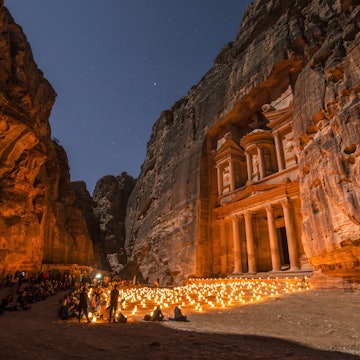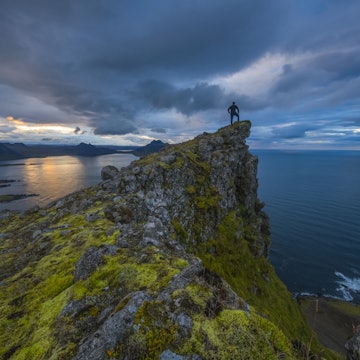

Reykjavik cityscape viewed from across the Tjornin lake. AsiaTravel/Shutterstock
Reykjavík and its surroundings are a magnificent theme park of adventure and beauty. The city itself offers vibrant culture, fresh flavors, fantastic shopping and nightlife as long as the summer nights. Just outside the capital you'll see geologic wonders found no place else, including hot springs, volcanoes and pristine coastlines. On top of that, you can enjoy soaring mountains, lava fields, brilliant hiking, horseback riding, adventure sports and more – these are days to savor and remember.
Embrace the best of Iceland's capital with these top things to do in Reykjavík and its surroundings.

1. Drink in Reykjavík's cafe culture
Coffee isn't just a means to warm up and/or perk up in Reykjavík, it's the basis for an entire culture. People gather throughout the day at idiosyncratic little cafes to share gossip, conduct business or just enjoy the act of being. There are barely any chains to be found, rather you'll delight in discovering scores of clever cafes such as the artful Mokka Kaffi, the cozy Kaffi Vínyl (vinyl cafe) and harborside Reykjavík Röst. Bonus points: pair your coffee with a tasty fresh-baked treat at places like Brauð & Co.
2. Shop as you stroll
There's nary an international chain in sight on Reykjavík's top shopping strip, Laugavegur St, where Iceland's best designers display their wares at alluring boutiques. Head to the Frakkastígur and Vitastígur end for top fashion.
Planning tip: Get the Icelandic sweater of your wooly dreams Friday through Sunday at the indoor Kolaportið flea market, where the prices are some of the best in the country.

3. Discover public art, from Hallgrímskirkja to Viðey Island
You'll find magnificent public art across Reykjavík. The largest of which is not only one of the city's top sights but is also an entire building: Hallgrímskirkja, the soaring concrete church that's a modern (1945–86) work of art. Another highlight is Hljómskálagarðurinn, a public park featuring statues by female artists.
Detour: A short ferry ride from Reykjavík, uninhabited Viðey Island is known for historic buildings, sweet silence and modern art, including sculptures by Richard Serra and Yoko Ono's Imagine Peace Tower.
4. Sail off to see whales
You have a great chance of seeing any of the nearly two dozen whales found right off Iceland's coast on a whale-watching tour from Reykjavík's Old Harbor. Tours are offered year-round, though April to September are the best months, given the longer days and decent temperatures.
Planning tip: Although specific puffin-watching tours are offered, it's not uncommon to see them as part of whale-watching tours.

5. Bathe in the warming waters of a public hot tub
Iceland bubbles over with naturally hot water that's famous worldwide, and you needn't travel far into the countryside to experience its enveloping pleasure. Sundhöllin is a whole complex right in the city center. Besides indoor pools and a hot tub, there are saunas and outdoor tubs with fabulous city views. To the east of the center, high-energy, but still public, Laugardalslaug boasts hot pots plus a huge pool, curling water slide and more – great for the kids. Regular bus services will take you from Reykjavík to Iceland's most famous geothermal pool: Blue Lagoon. It takes about 50 minutes one way but as one of the most visited attractions in the country, it's generally always busy.
Planning tip: All swimmers must shower completely using soap (provided in the changing area) before entering the pools.
6. Explore astonishing geologic beauty on the Reykjanes Peninsula
Flying in and out of Keflavík International Airport, you might get a glimpse of the magnificence of the Reykjanes Peninsula, but to appreciate this UNESCO Global Geopark, you need to go on a hike. Active volcanoes, hot springs, craggy lava fields, soaring mountains and wild ocean views are just some of the highlights. Many operators can guide you on these adventures.
Planning tip: Before heading out, always check the official source for safety news, safetravel.is. This particularly applies if you'll be going to areas of volcanic activity.

7. Graze on fresh food at Grandi Mathöll
One of the Old Harbor's vintage fish factories is reborn as Grandi Mathöll, a waterfront food hall with an unbeatable selection at over half-a-dozen stalls. Choices range from classic Icelandic fish and chips to spicy Indonesian.
Detour: Feeling a chill? Pick a fish skewer from the cooler and enjoy some warming lobster soup while it's on the grill at Sægreifinn (Seabaron), which is right on the harbor.
8. Be wowed at Reykjavík Art Museum and local galleries
For a small country, Iceland has a lot of fantastic artists. You'll find their work at a score of museums and private galleries across Reykjavík. The Reykjavík Art Museum has three locations, Ásmundarsafn (designed by sculptor Ásmundur Sveinsson), Hafnarhús (contemporary exhibitions near the Old Harbor) and Kjarvalsstaðir (devoted to local legend Jóhannes S. Kjarval). Among the galleries, don't miss: i8, Kling & Bang and Nýlistasafnið (Nýló; The Living Art Museum).

9. Soak in a lagoon just outside Reykjavík
Everyone's heard of Blue Lagoon, and for very good reasons: white steam rises from sapphire blue water framed by emerald-green moss atop jet-black lava. It's a sprawling pleasure complex where you can get a massage, a cocktail, a fabulous meal or just float your cares away.
Detour: Hit the Sky Lagoon, which is only 15 minutes south of Reykjavík and is much less crowded than the Blue Lagoon.
10. Revel in the rift-valley beauty of the world's first parliament site at Þingvellir
In 930 CE, the Vikings held the world's first democratic parliament in the stunning Þingvellir (pronounced Thing-vetlir) rift valley northwest of Reykjavík. Now enshrined as a UNESCO World Heritage Site and Þingvellir National Park, the area would be a must-see for its natural splendor even without the history. Follow marked trails to marvel at the geologic drama where the tectonic plates of North America and Europe tear away from each other, then visit the park’s waterfalls and absorb their power.
11. Ride a horse to a waterfall
The area around Hella, southwest of Reykjavík, is shadowed by volcanoes and laced by rivers. It's also a top region for horse breeding (especially cute Icelandic horses with their delightful bangs and unique gaits), and you can go horseback riding across the countryside with stops that include Ægisíðufoss waterfall. Operators include Íshestar, near Reykjavík or Hella Horses. Nearby Hvolsvöllur is another good center for riding, especially across lava fields.

12. Delight in Iceland's best nightlife
Djammið in Reykjavík means "going out on the town," or you might pöbbarölt – take a "pub stroll." Peak hours for partying out are midnight to 5am, which works well in summer, when it's the land of the midnight sun. But people are out in all seasons, and you can hear Iceland's renowned music scene from famous groups like Kaleo and Vök and up-and-comers at venues large and small.
Planning tip: Time your visit to one of Iceland’s music festivals, like Iceland Airwaves or Dark Music Days, or book tickets at the shimmering Harpa concert hall.
13. Taste Iceland's inventive cuisine
You'll find flavors as fresh and pure as the sea breezes in Reykjavík's restaurants. Case in point: Matur og Drykkur, a gastropub-style bistro with an ever-changing menu built around ingredients sourced from local farmers, seafood caught offshore and herbs foraged in the surrounding landscape.
Planning tip: No trip to Reykjavík is complete without a visit to world-famous hot dog truck Bæjarins Beztu Pylsur. Get one with everything.

14. Take a day trip to the Snæfellsnes Peninsula
North of Reykjavík, the Snæfellsnes Peninsula arrows out into the Atlantic. Much of the unmissable western tip is the Snæfellsjökull National Park, an enchanting landscape of lonely beaches (some with seals), waterfalls, moss-ringed ponds, old fishing villages, trails to ancient volcanic craters, horse-riding and even a glacier.
Detour: On the north side of the peninsula, Stykkishólmur is a cute-as-a-button harbor town with buzz and great restaurants.
15. Tackle a gleaming glacier
Langjökull Glacier is Iceland's second largest and is an easy drive from Reykjavík. Plunge deep into the glacier via an ice cave or careen across the vast expanse – its shiny white surface covers over 900 sq km (347 sq miles) – on monster tour trucks. There are also snowmobiling and other fun diversions for thrill-seekers.
















